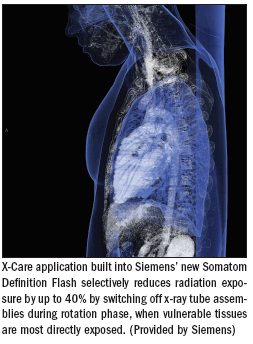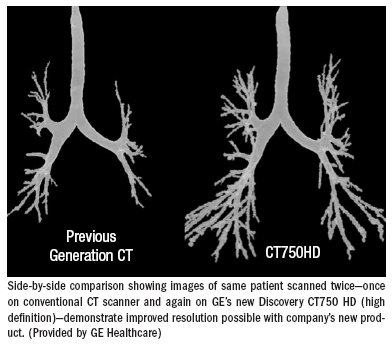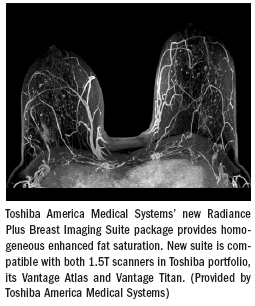MR, CT vendors hit rangeof price-performance points
The makers of CT and MR scanners opened the spigot of new introductions at RSNA 2008. They flooded the exhibit floor with products: some premium systems, others optimized to hit particular price points or address clinical niches.
The makers of CT and MR scanners opened the spigot of new introductions at RSNA 2008. They flooded the exhibit floor with products: some premium systems, others optimized to hit particular price points or address clinical niches.
Siemens Healthcare rolled out a new version of its dual-source CT, the Somatom Definition Flash, built on the company's unique dual-source xray technology. In its debut at RSNA 2008, the FDA-cleared system with the $2 million price tag promised to dramatically reduce dose and eliminate motion artifact in the chest while opening the door to routine scanning of the coronaries.
Despite using two x-ray tubes and matching detectors, the Definition Flash requires only a fraction of the radiation dose of other systems now on the market and exposes patients to just a third of the dose they naturally encounter in a year from background sources. A new filter purifies x-ray beams at high and low energies to emit only the planned spectra, enhancing tissue characterization.
Spiral heart scans can be done in a quarter of a second or about half a heartbeat. Rather than receive an increase in dose, as might be expected, patients undergoing a heart scan on the Definition Flash receive less than 1 mSv of dose.
Rotations every 0.28 sec provide the horsepower to cover 43 cm/sec and deliver a temporal resolution of 75 msec. Whole chests can be covered in just 0.6 sec, eliminating the need for breath-holds, according to the company. The scanner's extraordinary speed means staff will not have to sedate pediatric or trauma patients. This is possible because the second imaging chain, mounted in the gantry at a 90º angle to the first, provides the data that would otherwise be missed if a single-tube system were used.
The selective photon shield blocks unnecessary parts of the energy spectrum to improve separation of the two simultaneous scans with low and high energy. This can be used to classify the chemical composition of tissues or to reconstruct unenhanced CT images without administering x-ray contrast media or having to perform an additional examination.

The X-Care application selectively reduces radiation exposure when the scanner passes over dose-sensitive organs, such as the eyes and female breast. This is done by switching off the x-ray tube assemblies during the rotation phase, when vulnerable tissues are most directly exposed to radiation, reducing radiation exposure by up to 40%, according to Siemens.
Making its first trip to the RSNA exhibit floor was GE's Discovery CT750 HD (high definition). The superpremium CT scanner boasts technology shown as works-inprogress at last year's RSNA meeting, features that boost spatial resolution to 230 microns and improve contrast resolution 33% in the body to 21.5 lp/cm and 47% in the heart to 14 lp/cm, according to the company. Another improvement, Volume Shuttle, extends the breadth of GE's detector enough to dynamically cover whole organs, including the heart, lungs, brain, and liver.
Advances are based on a newly developed x-ray tube, generator, and detector. Particularly notable is the Gemstone detector, composed of garnet- based material. This, the first new detector material from GE in 20 years, is 100 times faster than the HiLite ceramic built into its predecessors, according to GE.
The unique components of the Discovery CT750 HD allow multispectral imaging, which GE calls Gemstone Spectral Imaging. Its capture of data at different energy levels may reveal information specific to certain clinical conditions and reduce or eliminate artifacts, according to the company. Different energies can be applied using a single detector and xray tube subsystem, which can switch between high and low energies in 0.5 msec, allowing physicians to look beyond the shades of gray and see Multispectral imaging may be used to distinguish liver lesions or types of kidney stones. It might also be leveraged to eliminate artifacts, such as calcium blooming, by subtracting calcium from vascular images.
In a two-pronged approach to the CT marketplace, vendors balanced their portfolios with products that either address new price-performance points or enhance existing systems to mitigate patient dose issues. A new configuration of GE Healthcare's 64- slice LightSpeed VCT cuts dose by up to 40% during routine imaging, according to the company. This new XTe configuration is the latest development in the VCT product line, which was launched in 2004.
Philips fired two salvos below the premium tier: One was its 128-slice Brilliance iCT SP scanner, the other the work-in-progress MX CT 16-slice device. The compact 128-slice scanner can be sited in a room measuring 365 square feet and can be scaled to deliver 256 slices per rotation if the needs of the facility grow, according to Philips. The new system has the same gantry rotation, 0.27 seconds, as the company's flagship 256-slice scanner and delivers the same 120 kW power. Its Smart Focal Spot x-ray tube technology enhances spatial resolution.
The Nano- Panel detector enables large area coverage for coronary artery imaging, lung scanning, and brain perfusion, while the Eclipse DoseWise collimator keeps a lid on dose. Philips' valuepriced 16-slice MX CT will appeal to cost-constrained customers looking to replace their current scanner or add a second one. The scanner is designed to perform routine applications, including CT angiography and virtual colonoscopy, as well as exams needed for dental planning, according to the company.

Siemens sought to go the 16-slice competition one better with the introduction of a 20-slice scanner, its Definition AS20. The AS20 is positioned between the company's 16- and 40-slice scanners in price, a position that Siemens executives hope will be a sweet spot for customers who want a high-performance scanner but can't afford one, at least not right now. The AS20 is upgradable to the 128- slice high end of the Definition family. The price for the upgrades is about the same as the difference in price between the 20- and 128- slice members, according to the company. Easing the transition to better performance, Siemens has set up a lease program that accommodates upgrades every 36 months yet keeps the lease payments the same by extending the term by 24 to 30 months.
On the MR side of the floor, two introductions-one by Philips, the other by GE-address a segment in the MR marketplace that showed growth, at least in the first half of 2008. Philips' Achieva 3.0T expands the range of 3T applications possible with routine scanning through higher speed and better image quality. It does so using a novel technology, christened MultiTransmit RF management, that automatically adjusts the radiofrequency signal to the specific body habitus and anatomy of the patient being scanned. The results, according to Philips, are higher acquisition speed as well as better image quality and consistency. Together, they promise new clinical possibilities for scanning the breast, liver, pelvis, and spine at 3T.
GE directed booth visitors seeking 3T to its Discovery MR750. The scanner, which began commercial shipments earlier this year, is designed to make 3T scans as easy to perform as those at 1.5T, with consistent results regardless of the operator's skill level. It simplifies and speeds both academic and routine studies with accelerated scan and reconstruction times, improved image uniformity, better resolution, and extended anatomical coverage, according to GE. Liver exams can be done in 15 minutes. Routine functional MRI and complete breast exams are possible in two sequences.
Compared with other 3T products in the GE portfolio, the MR750 has a streamlined user interface that cuts the number of steps to do scans by as much as 68%, according to the company. Time-saving features reduce patient setup time by up to 71%. A new thermal management system optimizes specific absorption rate and increases scan efficiency 17%. Improved gradients net a 60% increase in resolution, while an expanded fieldof- view boosts anatomical coverage. Parallel imaging algorithms built into ARC (autocalibrating reconstruction for Cartesian) are coupled with highdefinition coils to accelerate data acquisition. An optical RF system cuts noise and boosts signal, increasing the signal-to-noise ratio by 27%. Although the vendors of MR systems would like to make 3T the clinical benchmark, 1.5T remains the industry workhorse for most routine high-field scanning. It was little wonder, then, that major vendors of MR equipment sought to provide selections appealing to customers satisfied with the performance at this field strength.
GE unveiled its 1.5T Discovery MR450, featuring real-time cardiac imaging, multicontrast abdominal imaging in a single acquisition, and ultrahigh-resolution musculoskeletal scanning at high patient throughput. The short-bore superconducting 1.5T magnet onboard the MR450 provides high homogeneity even when imaging with a large or offcenter field-of-view. Discovery MR450 boasts workflow and productivity gains through additional anatomical coverage, increased acquisition speed, and intuitive protocols.
Philips extended its current 1.5T platform with the Achieva SE. It combines high-performance imaging and low capital cost through a sub-milliondollar price tag, lower operating costs, and compact siting. Achieva SE uses the same basic platform as the high-end Achieva 1.5T A-Series but repackaged without the more advanced clinical capabilities. Power-saving features reduce energy consumption and costs by up to 50%, according to the company.

The new Philips product will compete directly with Siemens' Essenza, a 1.5T scanner unveiled at RSNA 2007. Like the Achieva SE, the Essenza carries a list price of under $1 million (€0.76 million.)
This year Siemens brought to the RSNA exhibit floor a 1.5T system dedicated to breast imaging. The Espree Pink combines the 70-cm wide-bore design of the company’s general-purpose 1.5T Espree with the Vanguard coil supplied by Sentinelle, a breast coil that supports breast imaging and biopsy.
Toshiba America Medical Systems is approaching opportunities in breast MR from a different tack, seeking to extend the clinical applications of its installed base of high-field scanners with its Radiance Plus Breast Imaging Suite. The new suite is compatible with both 1.5T scanners in the Toshiba portfolio, the Vantage Atlas and Vantage Titan. The cornerstone of Radiance Plus is the new multichannel Radiance Plus Breast Imaging Coil, a bilateral, multielement coil designed to provide high temporal and spatial resolution for dynamic analysis and lesion characterization. The coil is mounted on the patient table to facilitate feet-first entry into the magnet. This allows patients' heads to remain outside the bore, reducing potential discomfort from claustrophobia, according to Toshiba.
New MRI Research Explores Links Between Waist-to-Hip Ratio and Memory in Aging
March 13th 2025Researchers found that a higher waist-to-hip ratio in midlife was associated with higher mean diffusivity in 26 percent of total white matter tracts in the cingulum as well as the superior and inferior longitudinal fasciculus.
Can Ultrasound-Based Radiomics Enhance Differentiation of HER2 Breast Cancer?
March 11th 2025Multicenter research revealed that a combined model of clinical factors and ultrasound-based radiomics exhibited greater than a 23 percent higher per patient-level accuracy rate for identifying HER2 breast cancer than a clinical model.